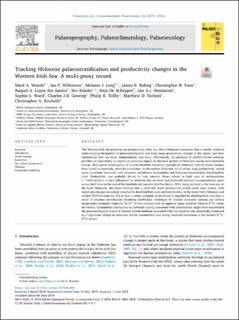| dc.description.abstract | The Western Irish Sea preserves an exceptionally thick (ca. 40 m) Holocene succession that is ideally suited to understanding the pattern of palaeostratification and water mass productivity changes in the region, and their relationship with sea level, sedimentation, and biota. Additionally, the presence of shallow-buried methane provides an opportunity to explore its potential impact on the local pattern of Holocene marine environmental change. Multi-proxy investigation of a cored borehole succession through the Holocene interval tracks changes from mixed to seasonally stratified conditions. In the earliest Holocene (11.2–10 ka), high productivity, mixed water conditions prevailed, with abundant and diverse foraminifera and dominant heterotrophic dinoflagellate cysts. Productivity was probably driven by high nutrient fluxes related to high rates of sedimentation (>1600 cm/kyr), in turn influenced by relatively low sea level and restricted sediment accommodation space across shelf areas to the east of the borehole site (eastern Irish Sea Basin). With rising sea level in the later part of the Early Holocene, the region evolved into a relatively lower productivity mixed water mass system, with significant changes in ecology revealed by dinoflagellate cysts and foraminifera. In the latest Early Holocene and earliest Mid Holocene (ca. 8.4–8.2 ka) a return to higher productivity is signalled by dinoflagellate cyst data; a result of seasonal stratification becoming established, evidenced by sharply increased summer sea surface temperature estimates (typically 16–17 °C) that contrast with an opposite (more positive) trend in δ18O values for benthic foraminifera. Reductions in turbulent mixing associated with stratification might have exacerbated the palaeoecological impact of shallow-buried methane associated with the borehole site, potentially evidenced by a significant change in dominant benthic foraminifera and strong, localised excursions in the benthic δ13C/δ18O record. | |

